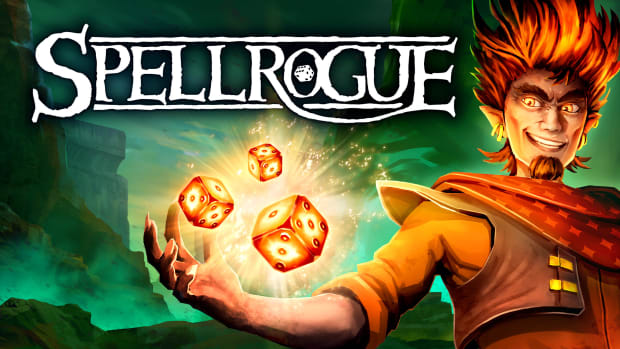Spellrogue is crossing Slay the Spire with Dicey Dungeons and it’s a hit

No matter how many times you’ve made a run through Slay the Spire, you’ll be back eventually and you’ll enjoy it. Its mixture of deckbuilding and roguelike gameplay is captivating. Spellrogue, developed by Guidelight Games and published by Ghost Ship Publishing, is very open about it being inspired by Slay the Spire – and playing it at gamescom 2023, I would’ve been able to easily call the developers liars if they had said otherwise, because it’s quite obvious: It’s just as brilliantly addictive.
The core gameplay loop of choosing a specific character, the decisions you make about which path to take as you crawl through the dungeon (there are battles, elite encounters, resting spots, and shops), the way the turn-based combat progresses – it’s all familiar and thus very easy to get into. There are even the same three potion slots you can use. Winning battles, you can add more cards to your deck, throw them away, or put them into your reserve pile so that you can perhaps upgrade and slot them into your hand later.

Your deck is going to be a lot smaller than on a run in Slay the Spire, where cutting down on the size of it is an important part of the strategy, and that’s because despite all the similarities between the titles, the team as Guidelight Games built something distinctly different.
Spellrogue is as much a deckbuilder, but less of a card game than Slay the Spire. You don’t draw, discard, and shuffle, using on your turn what fate decided to give you. Your deck of cards instead represents your abilities and all of them will be permanently available to you right from the start of a battle. Paired with Slay the Spire’s energy management, this would make for a rather dull combination. That’s where the other big part of Spellrogue is coming in: dice.
At the start of your turn, you throw a handful of dice, which will be your resource to spend on abilities. Each card in your deck has a certain requirement to be activated. Simple attacks will require a die that’s rolled a number from three to six or something like that. Others require two dice with the same number, a die with a straight number, a die with a roll above or below a certain number, or they want to be fed dice until they’ve eaten a certain number, say a six, giving you flexibility on which dice you spend on them (just a six, or a four and a two, and so on). Some cards include the numbers on the dice you use to activate them when calculating their damage or block value, adding in another factor to consider when planning your turn.

Naturally, many abilities on cards revolve around the manipulation of dice – rerolling the lowest or highest die or all of them, lowering all their numbers by a certain amount, and so forth. If you can think of a way to play around with dice and their rolls, Spellrogue probably has a card for it. And that’s very necessary, because I imagine that leaving everything to pure luck would make the game a lot worse. As things stand, though, the developers give you so many tools to play around with your rolls, so that you’ll at least be able to make a few moves happen during your turn – provided you’ve built a somewhat sensible deck.
Spellrogue really manages to make that combat system satisfying – once you’ve got a rough build going and start setting up powerful combos, it’ll have you in its grasp. I played a magic caster at gamescom and went for a glass cannon build, neglecting to include defensive skills into my hand. The best defense is a powerful offense, right? Some of my abilities were buffs, which amplified the outgoing damage once activated, so I always had to try and get those up before activating any offensive skills, if possible.
It’s essentially like energy management in other games, with the main difference being that you actually have some control over things due to abilities being able to change the dice during your turn. I realize it’s a bit ironic to say that, given so much of the game is subject to Lady Fortune with all the dice rolls. Yes, luck definitely plays a role – but you get many tools to mitigate its importance.

Aside from your cards, these include the already mentioned potions as well as artifacts you get from bosses or purchase in shops. Again, that’s very familiar. As are other features, like different damage types and status effects that give combat more spice and depth. Mechanically, this title is not afraid of going really deep – and it’s benefiting a lot from that. It feels great to play, it looks very good in motion, and it triggers that ‘just one more run’ instinct all of us have deep down.
If you’re a fan of games like Slay the Spire, Spellrogue is going to be a must-have for you. It’ll be out on PC “soon” to eat away at your time, but you can already join the ongoing playtests via Steam.
